After the incredibly fascinating visits to the three “coloured” temples in the city of Chiang Rai in northern Thailand – the White, the Blue and the Black temples – I continued even further north with the group I had set out with from Chiang Mai earlier that morning.
To start with and as a reminder, here is a map of Thailand marking all the places I visited during my journey in February/March 2023. The locations mentioned in this part of the travel story are in the northern part of the country.
Our next destination on that day was a small village inhabited by members of the Karen ethnic group. The majority of the Karen people live in Myanmar, but there is also a significant population in Thailand.
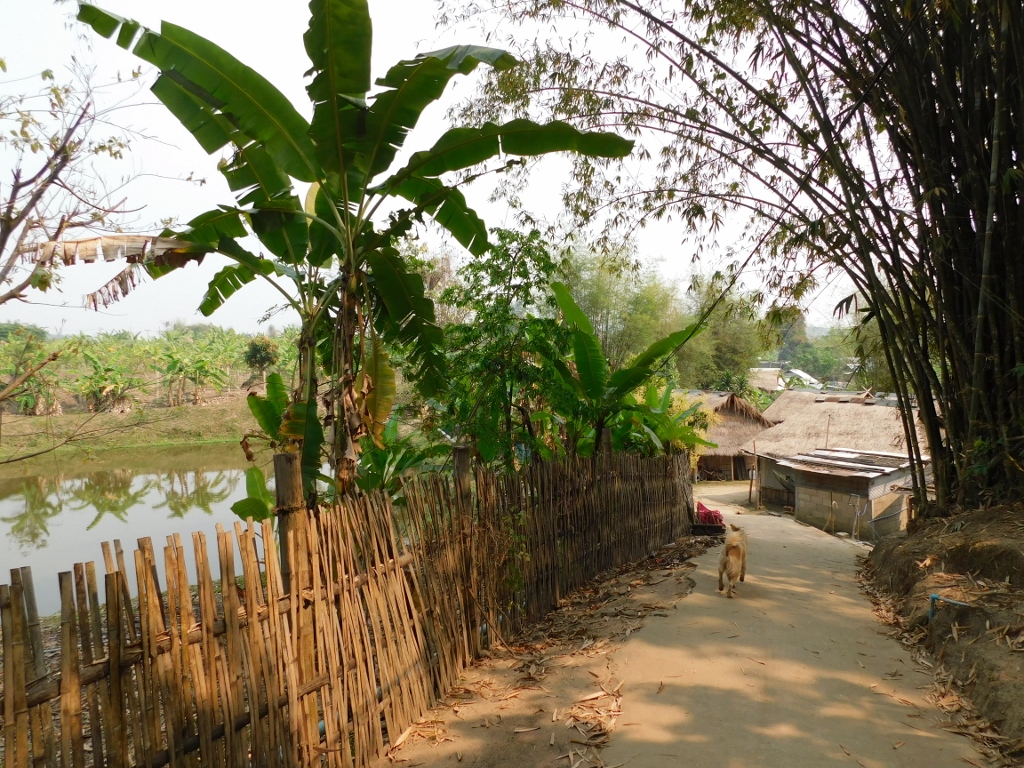 Karen village in the north of Thailand
Karen village in the north of Thailand
 Karen village in the north of Thailand
Karen village in the north of Thailand
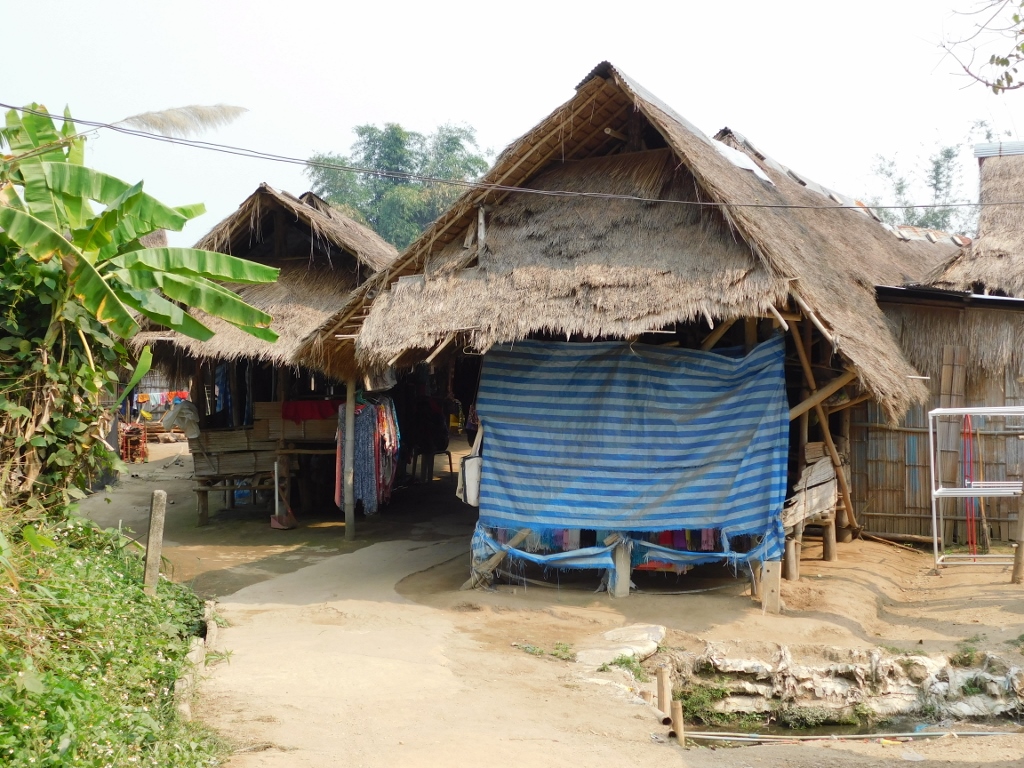 Karen village in the north of Thailand
Karen village in the north of Thailand
The main reason tourists come here is not, of course, to see the houses where people live, but because the women in this village are known for the custom of wearing neck ornaments, resulting in the elongation of their necks over numerous years.
First, let me say that this custom is not typical for all Karens but only for members of the subgroup called Padaung since Karens are not a homogeneous people, but consist of several subgroups. On the other hand, visitors are often not very concerned about these distinctions and such places are usually marked on the map as Long Neck Karen Village or something similar. When I say “such places,” that’s precisely what I mean – as far as I could notice on the map, there are several villages, albeit in the same area, where this custom can be observed.
In order to enter these villages, the visitors may pay a relatively expensive entrance fee. To give an example – the entrance fee to the Long Neck Karen Village, visited by the group I was with on this excursion, is 6 times higher than the ticket to visit the White Temple. In absolute terms, the price is certainly not too high, but I’m just giving an example. Guides usually say that the collected money helps the members of the local community, but to me, it sounds like a common phrase used to explain some charges, where the majority of the money often goes to the organisers. I don’t know if this applies in the case of the Long Neck Karens, but it is a fairly common practice in today’s world.
To start with, a dirt road leading to the village passes by stalls with various goods offered to tourists. However, what caught my attention more was the ornament on the head of a woman selling items here.
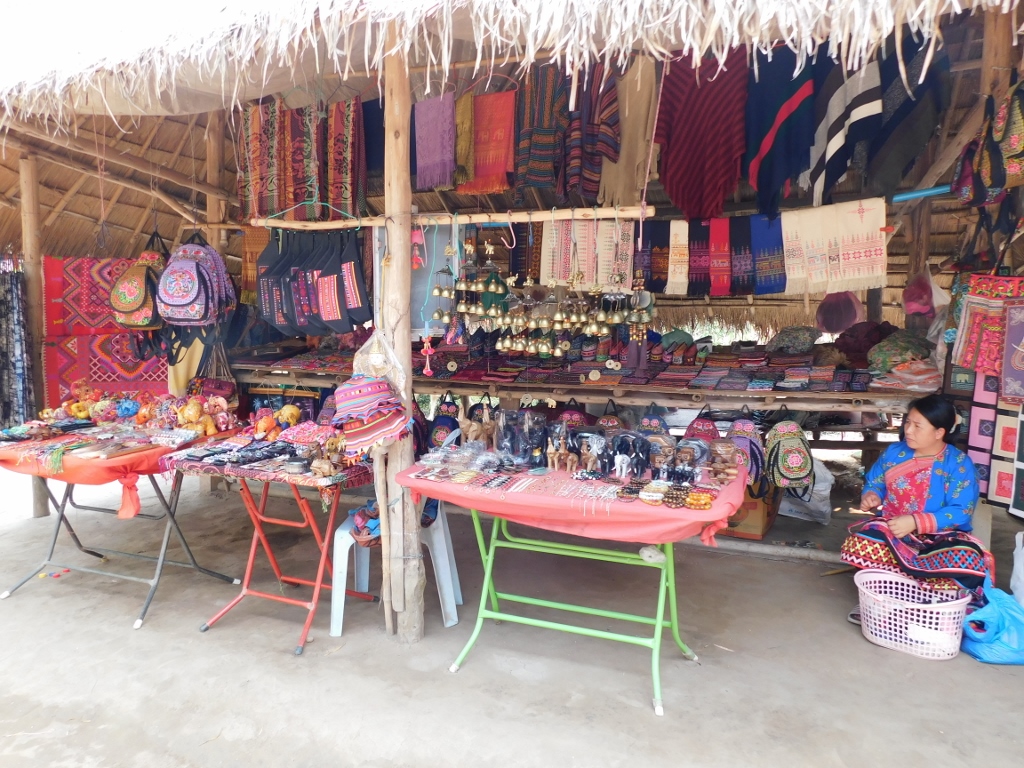 Long Neck Karen Village in the north of Thailand, a detail
Long Neck Karen Village in the north of Thailand, a detail
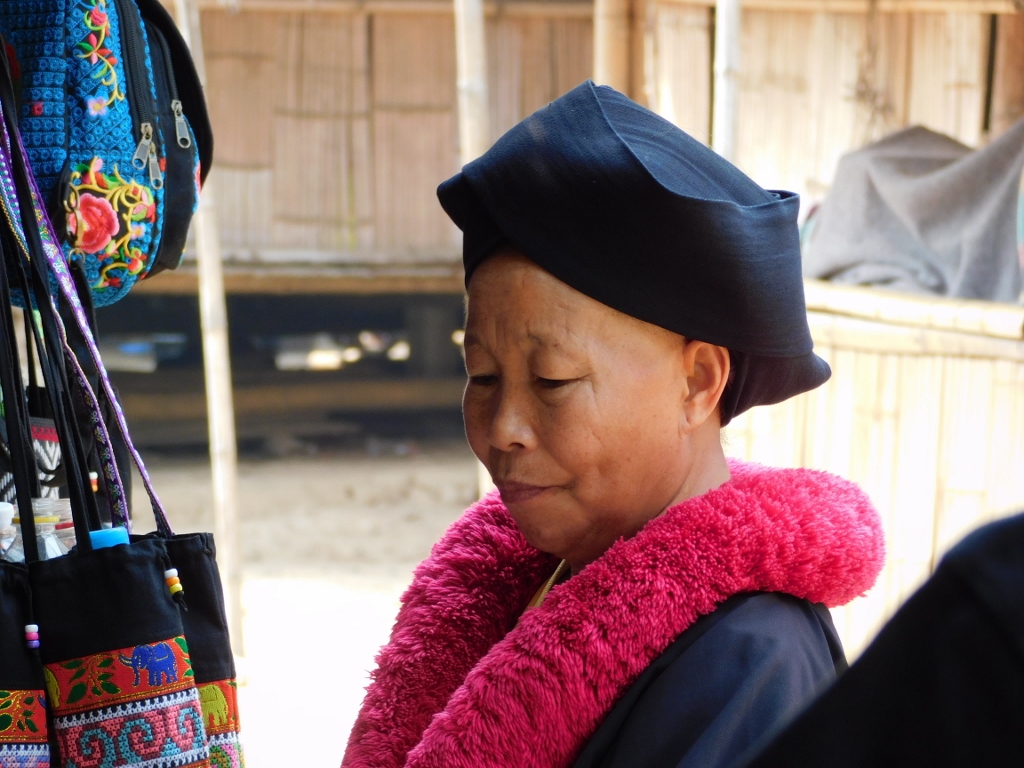 Long Neck Karen Village in the north of Thailand, a detail
Long Neck Karen Village in the north of Thailand, a detail
On the outskirts of the village, besides the laundry that was drying, two little girls who were already prepared for the visit of tourists could be seen. I couldn’t shake off the impression that this custom, initially a traditional element in the lives of some Karens, has transformed into a commercial endeavour. However, like other members of the group, I had already paid the entrance fee, so I decided to fully embrace and enjoy what awaited me.
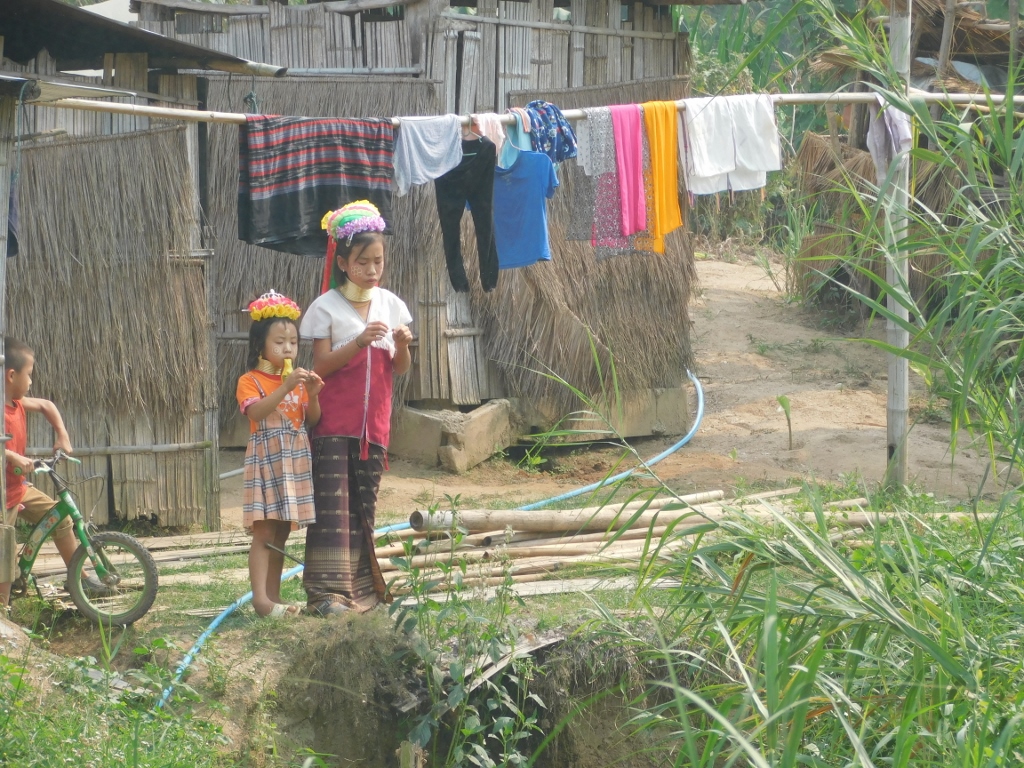 Long Neck Karen Village in the north of Thailand, a detail
Long Neck Karen Village in the north of Thailand, a detail
The visitor route then leads into an elongated courtyard surrounded by stalls with a large quantity of merchandise for sale. Some items were specifically related to the long-necked Karens, while others were of a general nature, such as a significant portion of souvenirs and clothing for foreigners found throughout Thailand.
 Long Neck Karen Village in the north of Thailand, a detail
Long Neck Karen Village in the north of Thailand, a detail
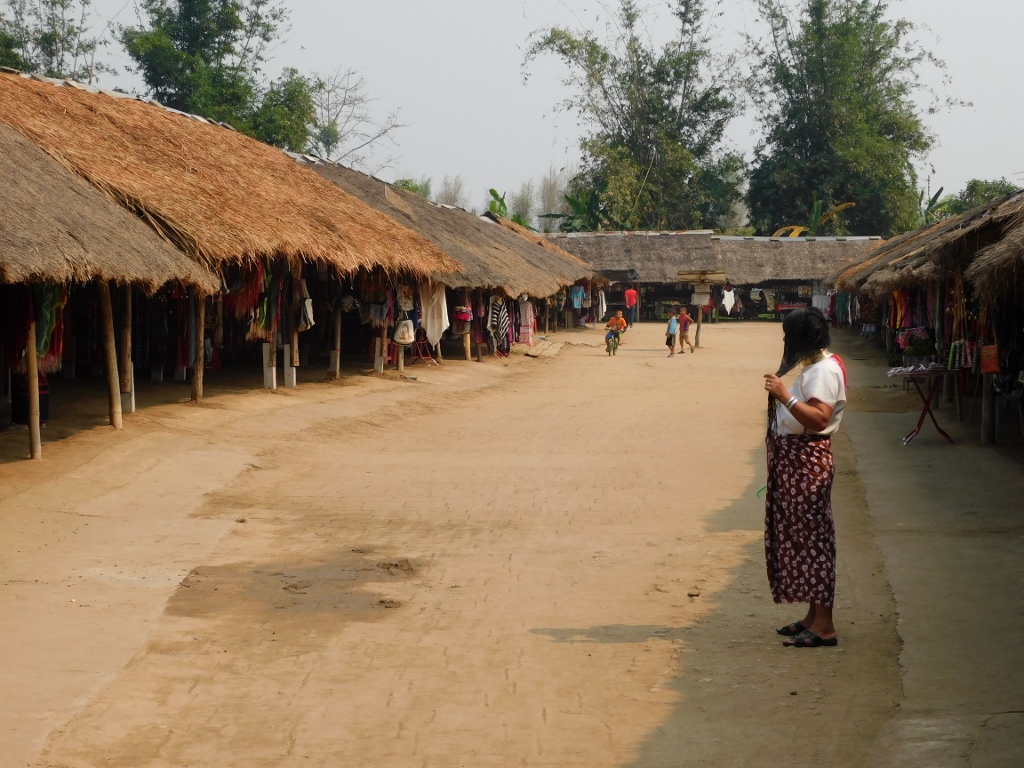 Long Neck Karen Village in the north of Thailand, a detail
Long Neck Karen Village in the north of Thailand, a detail
As soon as you enter the courtyard, you can see women, mostly already ready for photographs, taking up positions as if engaged in domestic crafts.
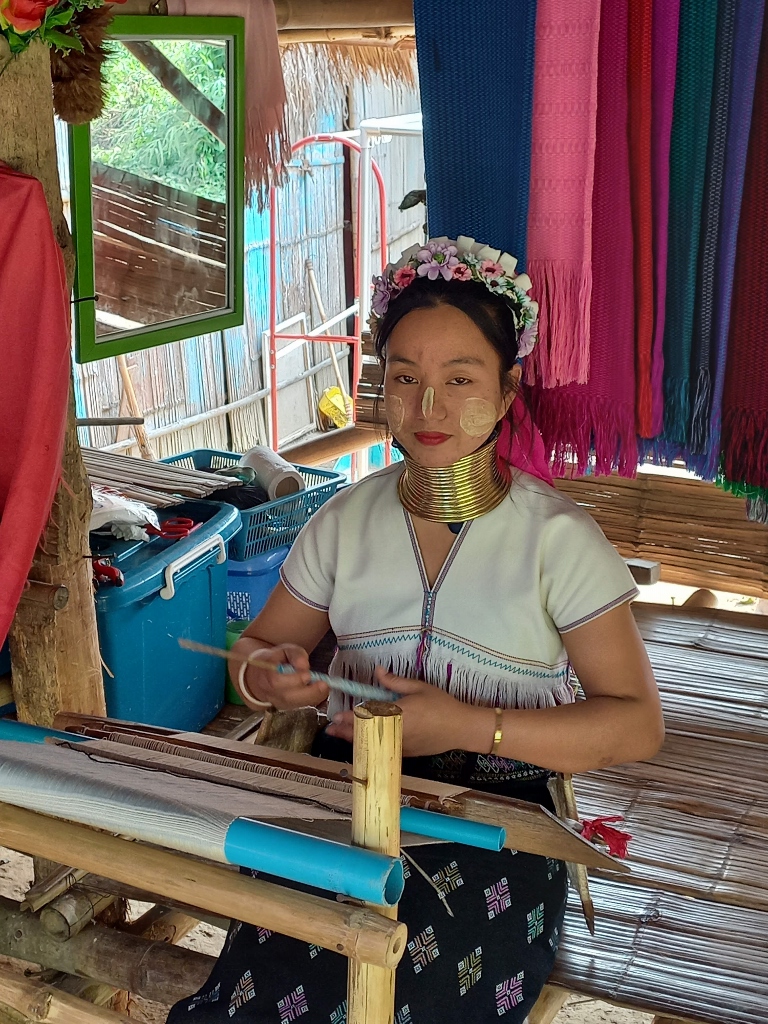 Long-neck Karen woman
Long-neck Karen woman
A young girl from my group quietly commented on feeling uncomfortable taking photos of the Karen women sitting here, although she wanted to. I think I explained to her nicely that this was a part of their job or, rather, the marketing and that, after all, they make a living from it, up to a point. On the other hand, the “stylists” had already prepared them well, so it would be a shame for so much effort to go to waste.
 Long-neck Karen woman
Long-neck Karen woman
And yet, these few young women I initially photographed still have a lot to learn from their older “colleagues.”
 Long-neck Karen woman
Long-neck Karen woman
 Long-neck Karen woman
Long-neck Karen woman
Unlike the Karens belonging to the younger generations, I believe that older women are not only more experienced in posing, but also that they have genuinely and traditionally worn these neck rings for many, many years. After all, this is quite evident when observing them.
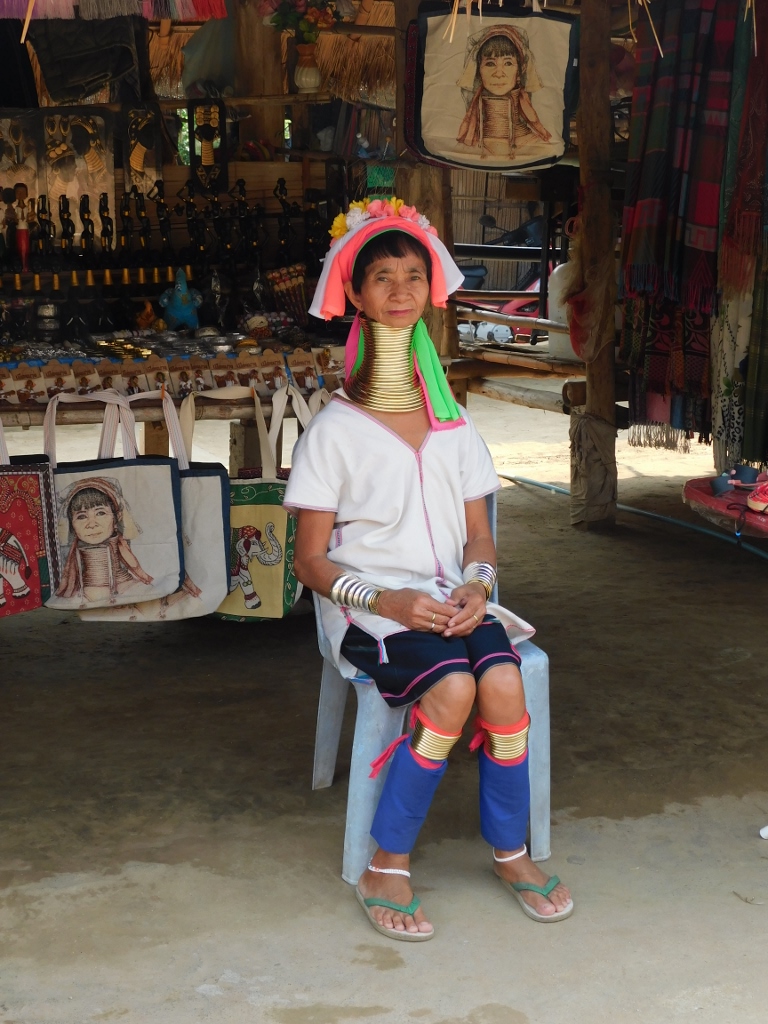 Long-neck Karen woman
Long-neck Karen woman
 Long-neck Karen woman
Long-neck Karen woman
The exact origin and purpose of this custom are unclear, but there are various stories. One of them suggests that wearing neck rings helps women defend themselves better against tigers, since tigers typically grab their victims by the neck and in this way they cannot strangle their victim, if she is a Karen woman. Today, there are no tigers here, but the tradition has persisted and it is sufficiently picturesque for foreign visitors. On the other hand, I don’t know how to explain the leg rings that most of them wear. Do they hinder escaping from a tiger, making it easier and faster to check if the neck rings work?
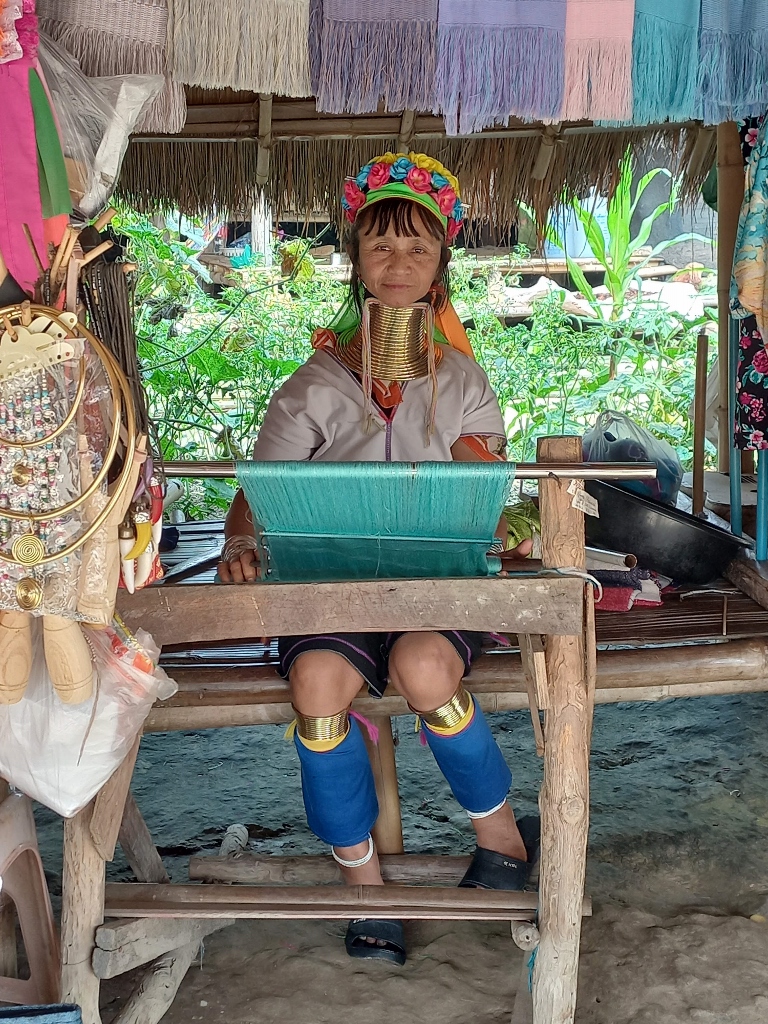 Long-neck Karen woman
Long-neck Karen woman
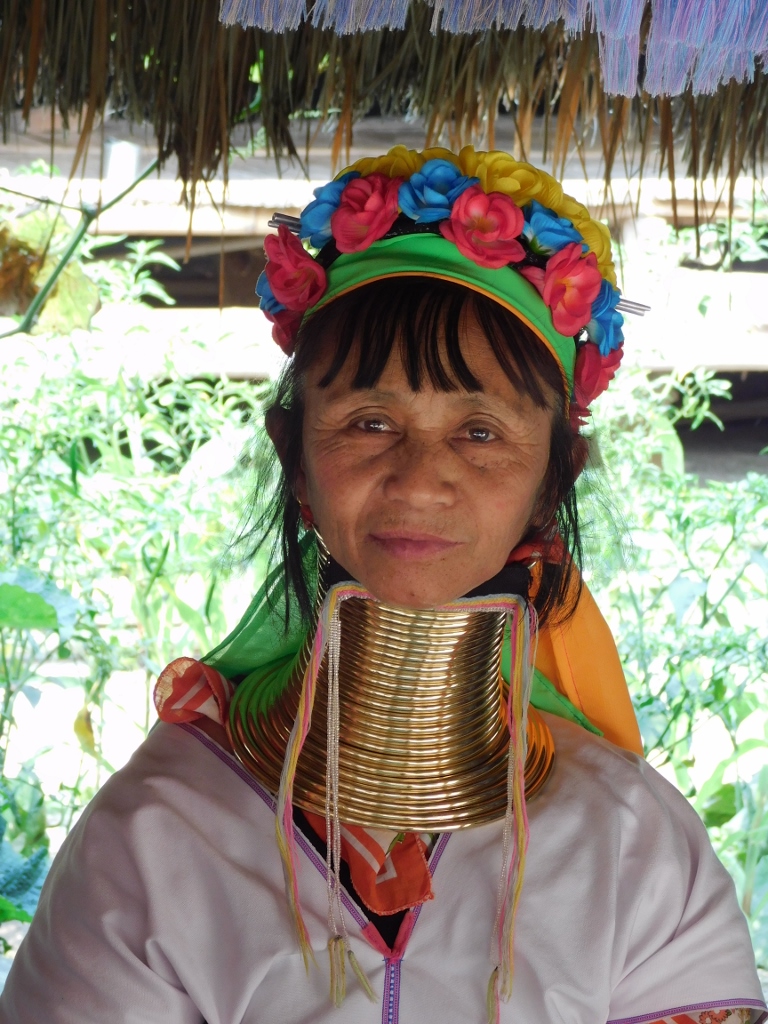 Long-neck Karen woman
Long-neck Karen woman
I also noticed another interesting aspect – not all women selling goods or engaging in handicrafts wore neck rings. One of them had large metal hoops in her ears, and it was clear that her earlobes had stretched significantly. This should not be surprising, since members of another subgroup – the Kayaw people – are actually called “Big Ear Karens.”
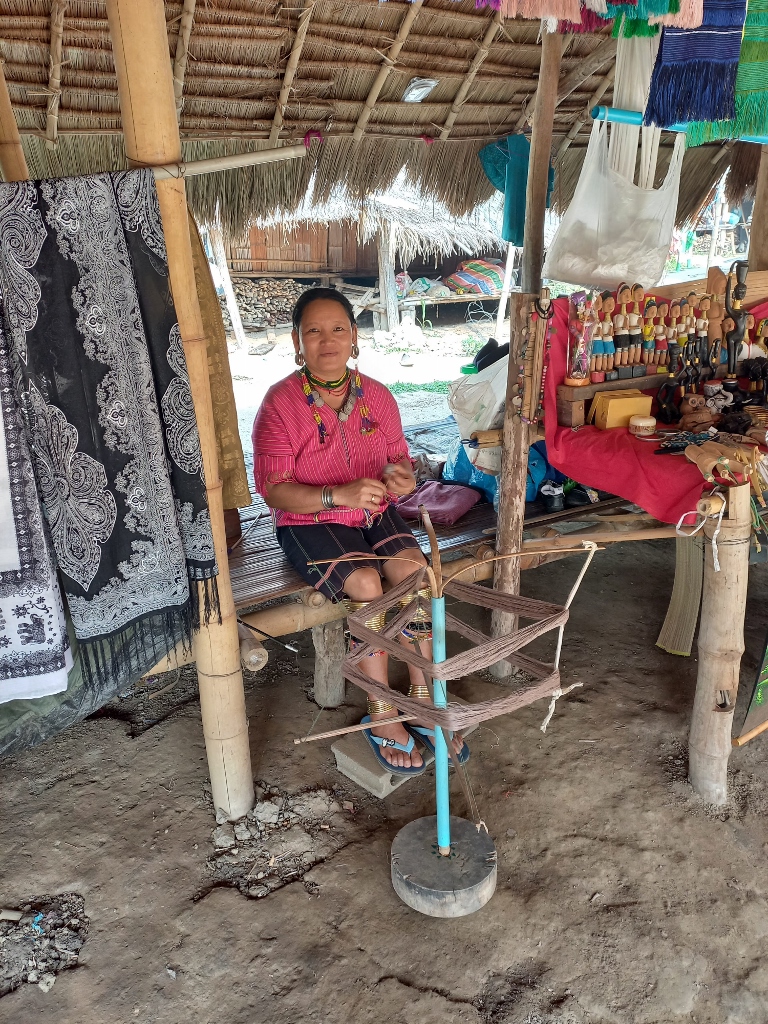 Big Ear Karen woman
Big Ear Karen woman
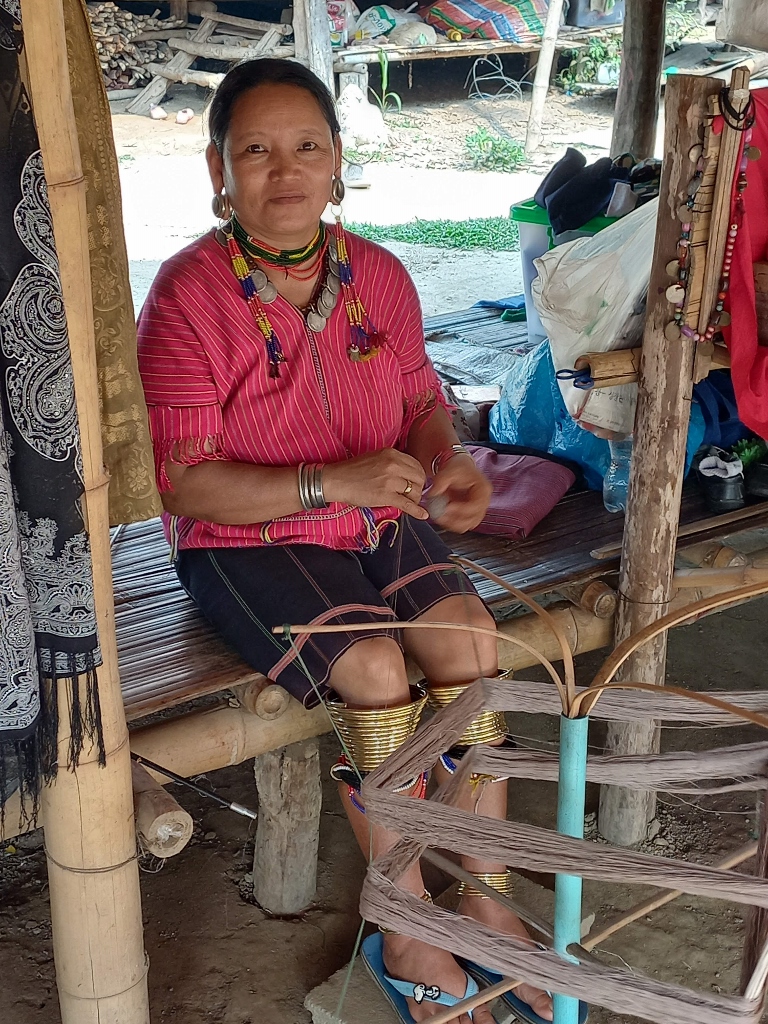 Big Ear Karen woman
Big Ear Karen woman
Meanwhile, in the courtyard, a little girl was playing.
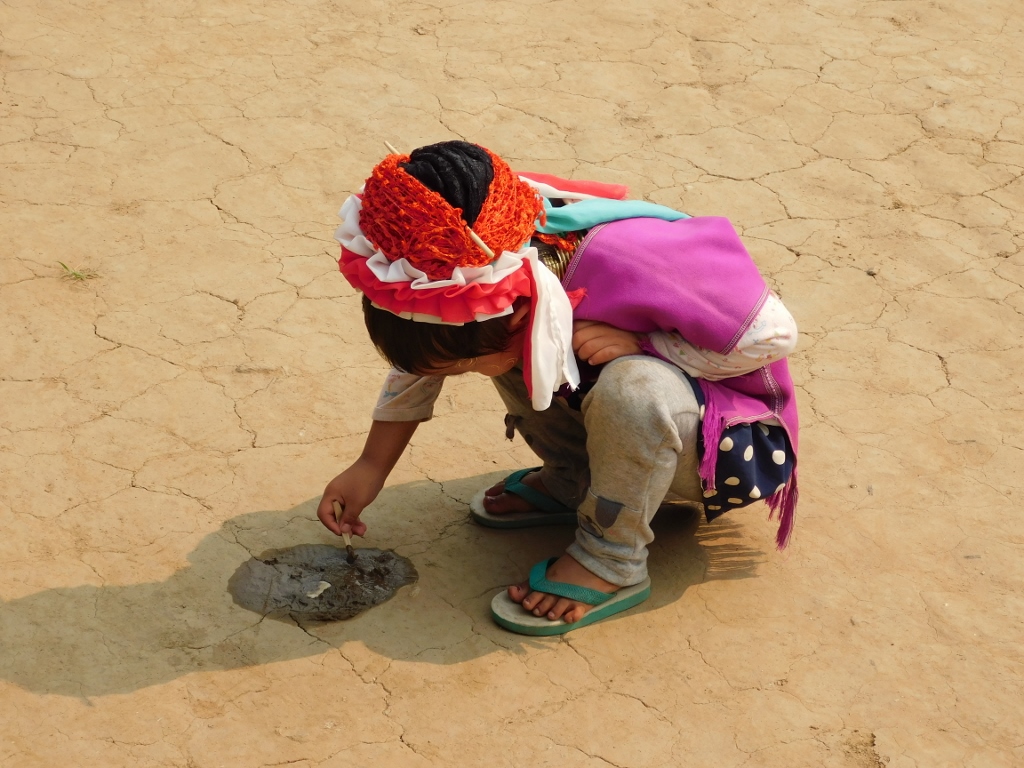 Long Neck Karen Village in the north of Thailand, a detail
Long Neck Karen Village in the north of Thailand, a detail
In the meantime, the men were either repairing a house in the village or constructing a new one. It was unclear.
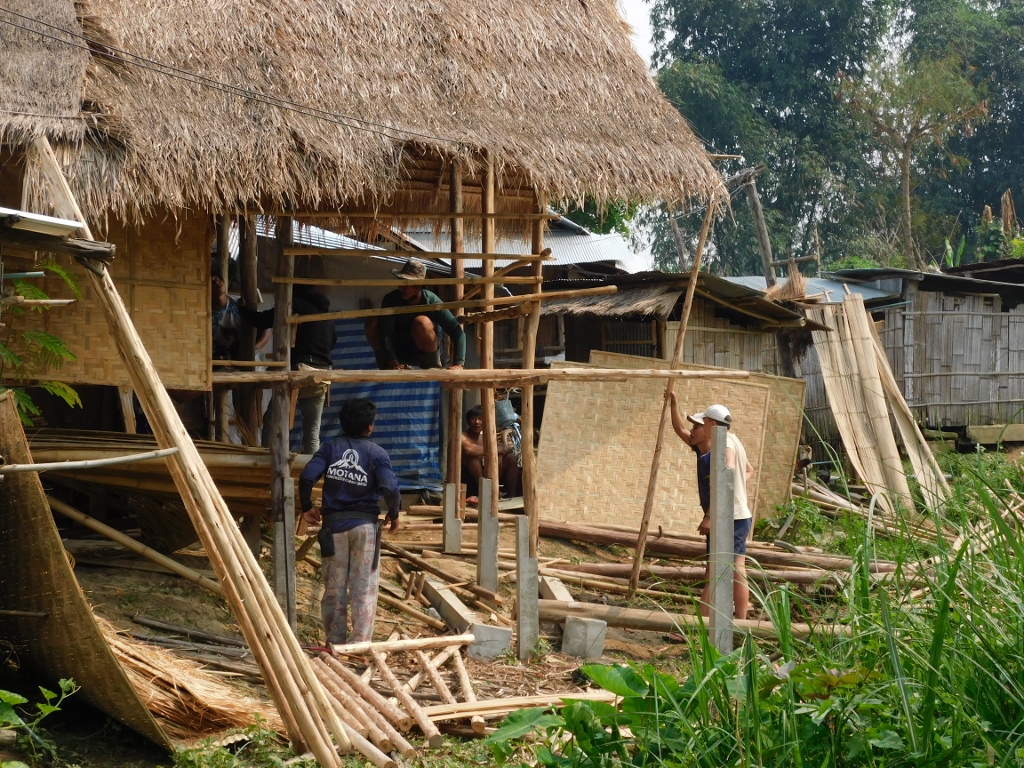 Long Neck Karen Village in the north of Thailand, a detail
Long Neck Karen Village in the north of Thailand, a detail
After photographing the Karen women with long necks and big ears, we strolled a bit more through the second part of this smallish village.
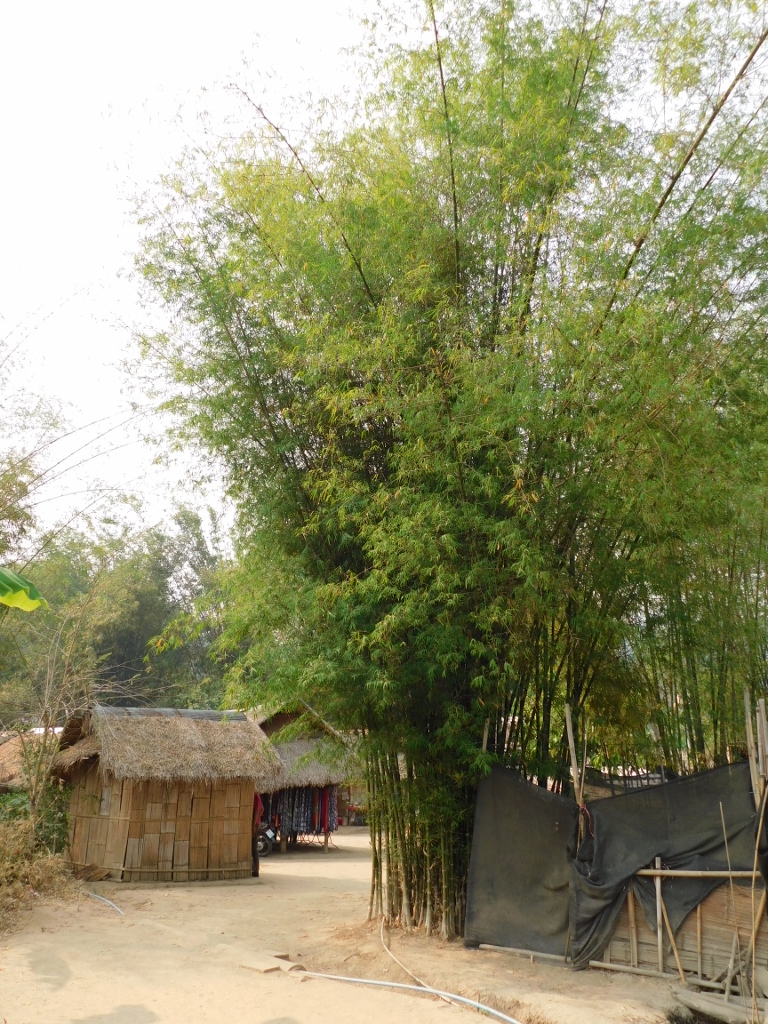 Karen village in the north of Thailand
Karen village in the north of Thailand
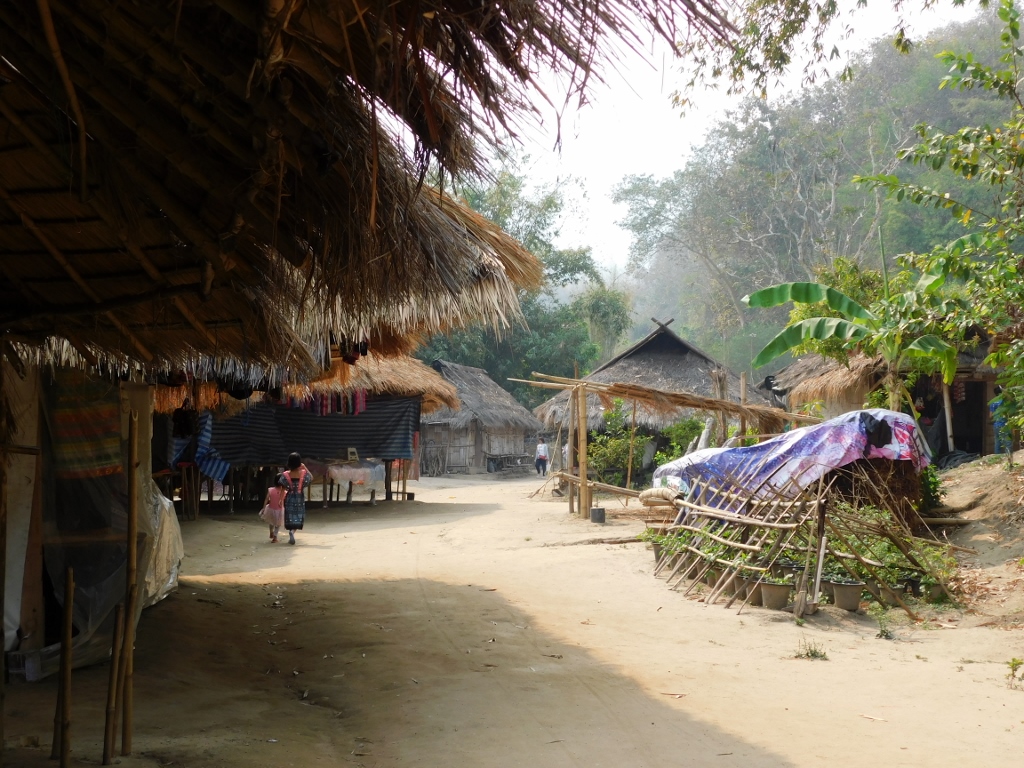 Karen village in the north of Thailand
Karen village in the north of Thailand
There are also contemporary residents who can be absolutely beautiful without long necks or big ears. This girl was kind enough to agree to be photographed.
 Gorgeous resident of a Karen village in the north of Thailand
Gorgeous resident of a Karen village in the north of Thailand
While my group was scattered around the village, buying souvenirs, I went down the path to the nearby rice field. The colour was incredible.
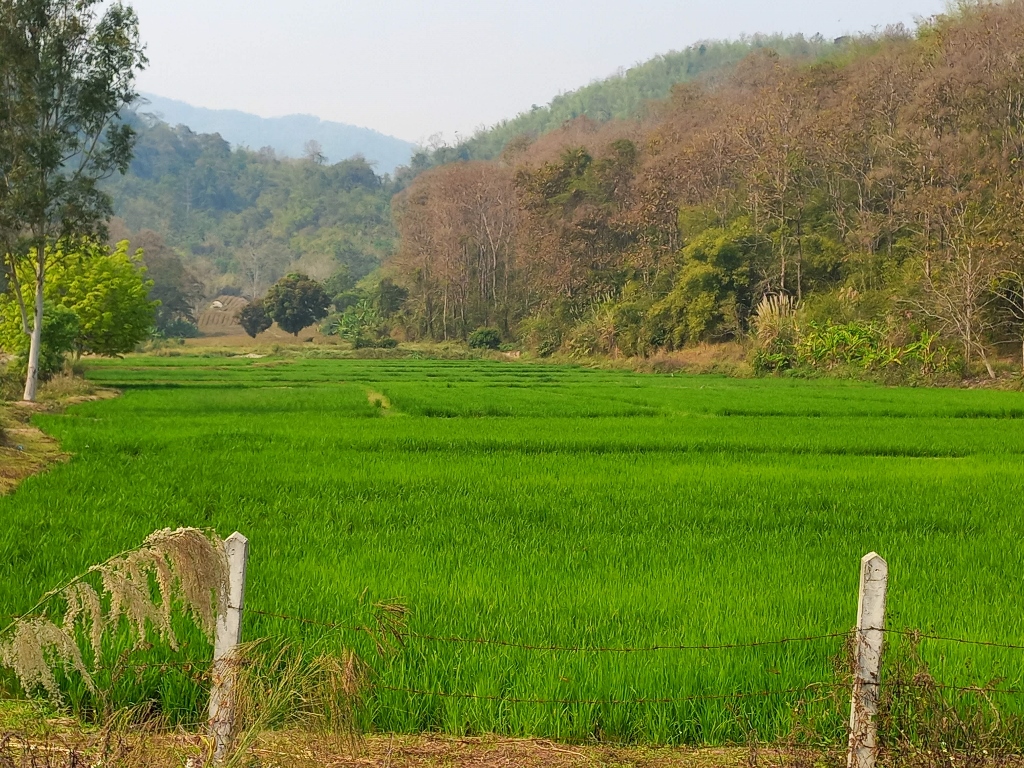 Rice field
Rice field
Next to the field, there was some kind of a pond and there I saw a person who later turned out to be a woman collecting something from the surface. She was doing it diligently and later consulted, I assume, with her husband.
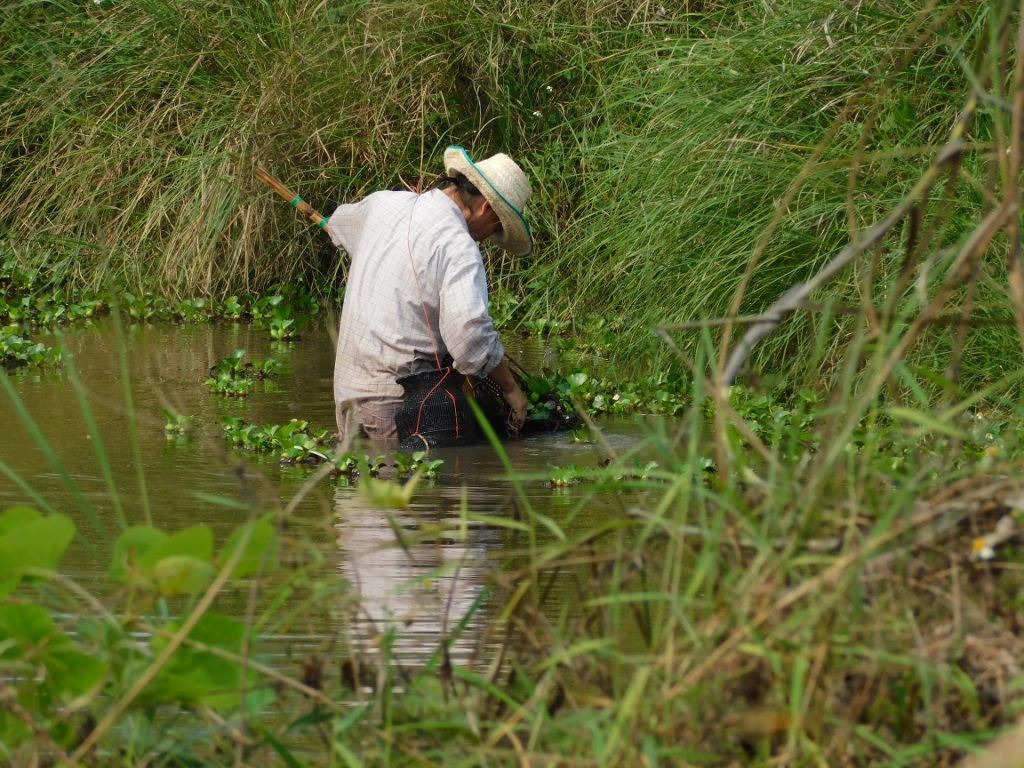 Karen village in the north of Thailand, a detail
Karen village in the north of Thailand, a detail
 Karen village in the north of Thailand, a detail
Karen village in the north of Thailand, a detail
And, as for the one-day trip I embarked on this day, there was still about 55 km left to reach an exceptionally interesting place. It was the Golden Triangle.
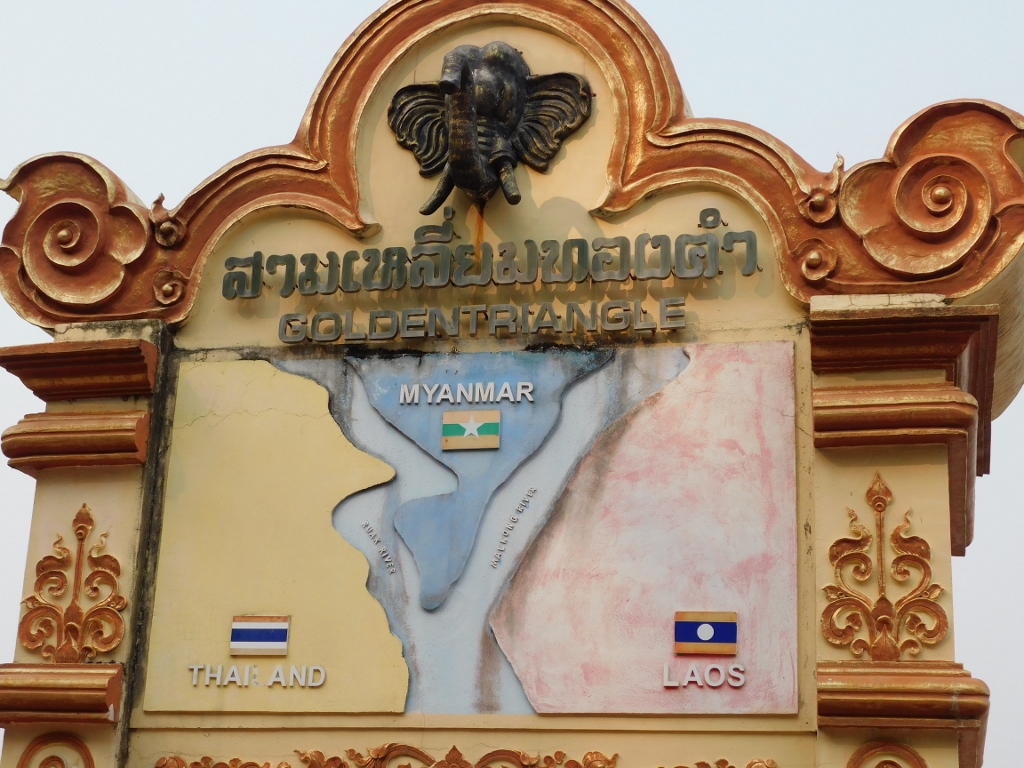 Golden Triangle
Golden Triangle
Although, historically speaking, the Golden Triangle refers to the region around the tripoint of Thailand, Myanmar and Laos, known for opium and heroin production (in the recent decades, Afghanistan has taken the lead in this area), in the geographical terms, this area is interesting because these three countries share their mutual borders in an intriguing way.
As it can be inferred from the previous photo, two rivers converge here – the Ruak and the Mekong or, more precisely, the Ruak flows in from the northwest and merges with the Mekong that comes from the northeast and continues to flow southwards. This, on the other hand, divides the land and over time various states have emerged, so west of the confluence is Thailand, to the north is Myanmar and to the east is Laos.
On the Thai side, there is an elevation that offers a beautiful view of the confluence. From what I’ve seen on the internet, it all looks much, much better when the weather is clearer, without haze, and when the sky is blue. But what can you do – I was here in early March 2023 and the situation was just as seen in the photographs – quite grey.
 Confluence of the Ruak and the Mekong
Confluence of the Ruak and the Mekong
It was still interesting to see that the colour of the water in these two rivers is entirely different and that, for a while, they flow parallel with a clear dividing line. The Ruak appeared muddier than the Mekong and this might be even more evident in the photo below.
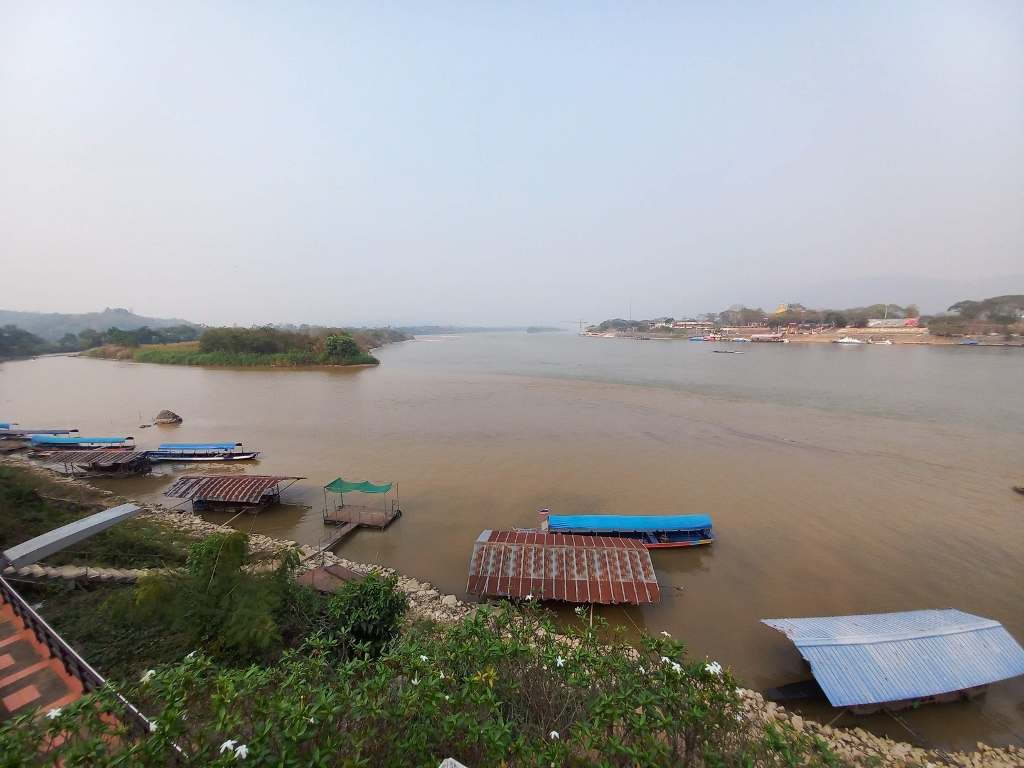 Confluence of the Ruak and the Mekong
Confluence of the Ruak and the Mekong
Before we started with our walk in this elevated area, I took some more photos, including those of local boats.
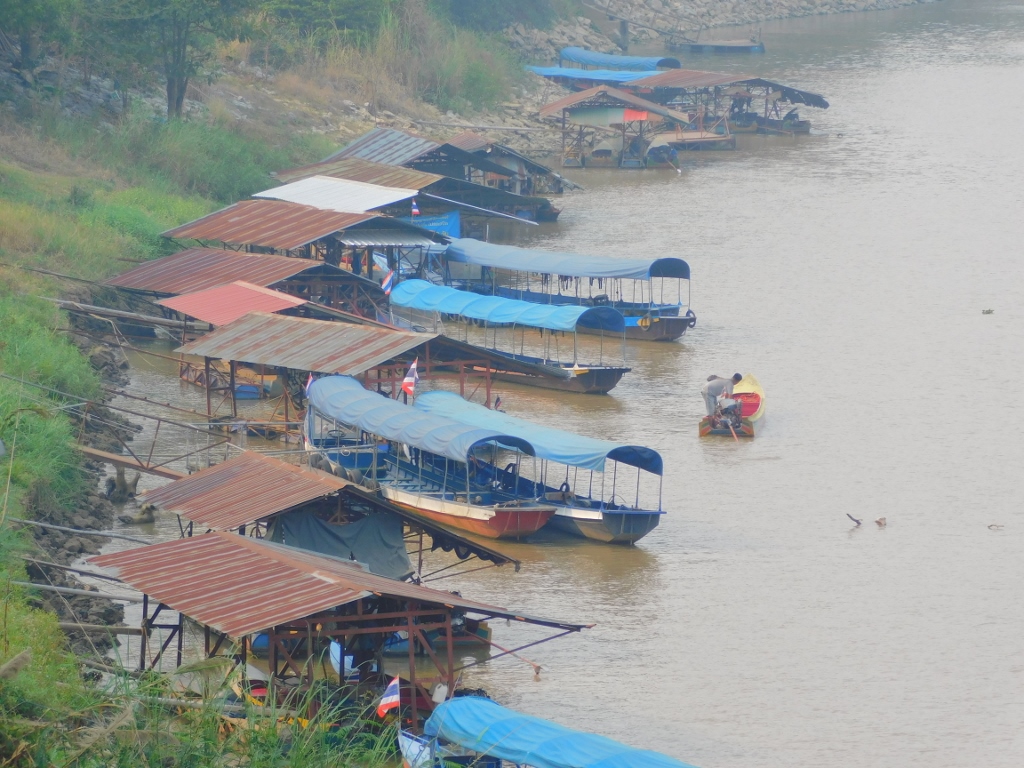 Confluence of the Ruak and the Mekong, a detail
Confluence of the Ruak and the Mekong, a detail
By now, I had become accustomed to the Thai people’s strong affinity for the golden colour, as well as for the vibrant and picturesque details that could be seen in abundance along the promenade parallel to the Mekong. Of course, there was also a gigantic golden Buddha.
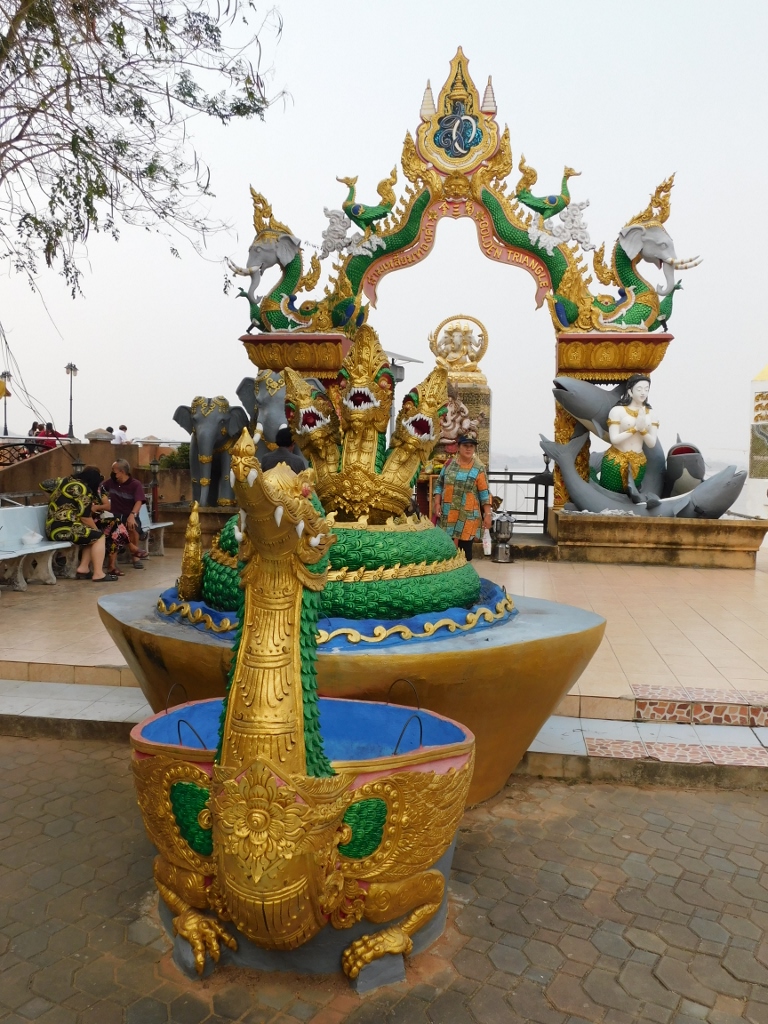 Promenade near the confluence of the Ruak and the Mekong, a detail
Promenade near the confluence of the Ruak and the Mekong, a detail
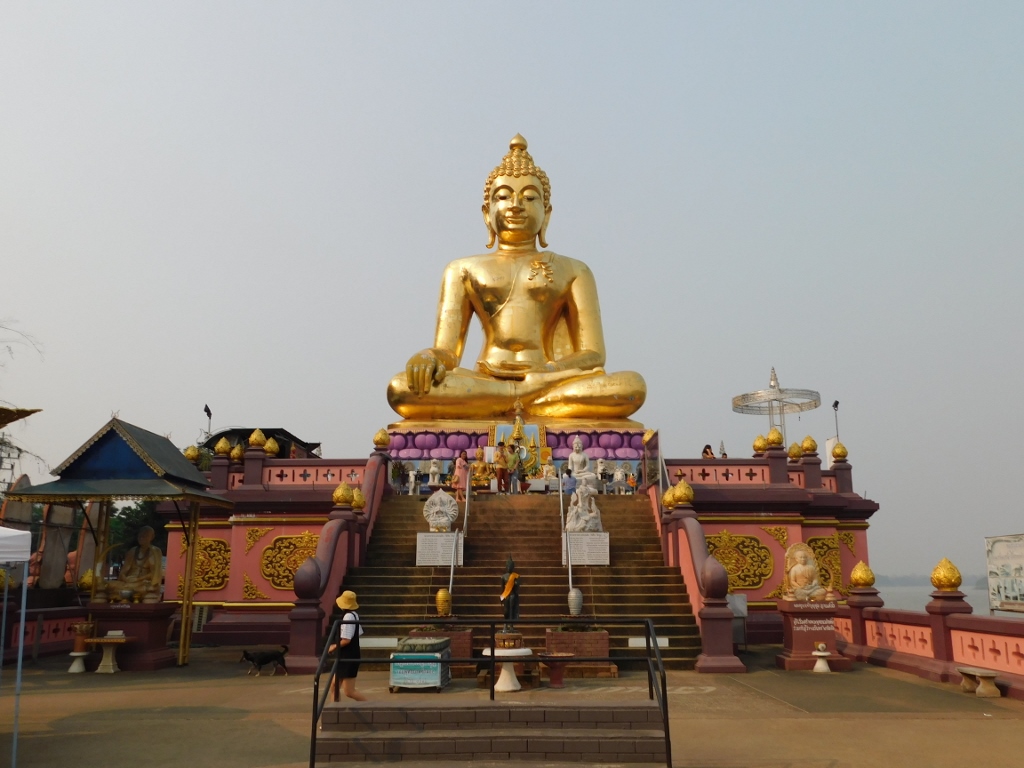 Promenade near the confluence of the Ruak and the Mekong, a detail
Promenade near the confluence of the Ruak and the Mekong, a detail
 Promenade near the confluence of the Ruak and the Mekong, a detail
Promenade near the confluence of the Ruak and the Mekong, a detail
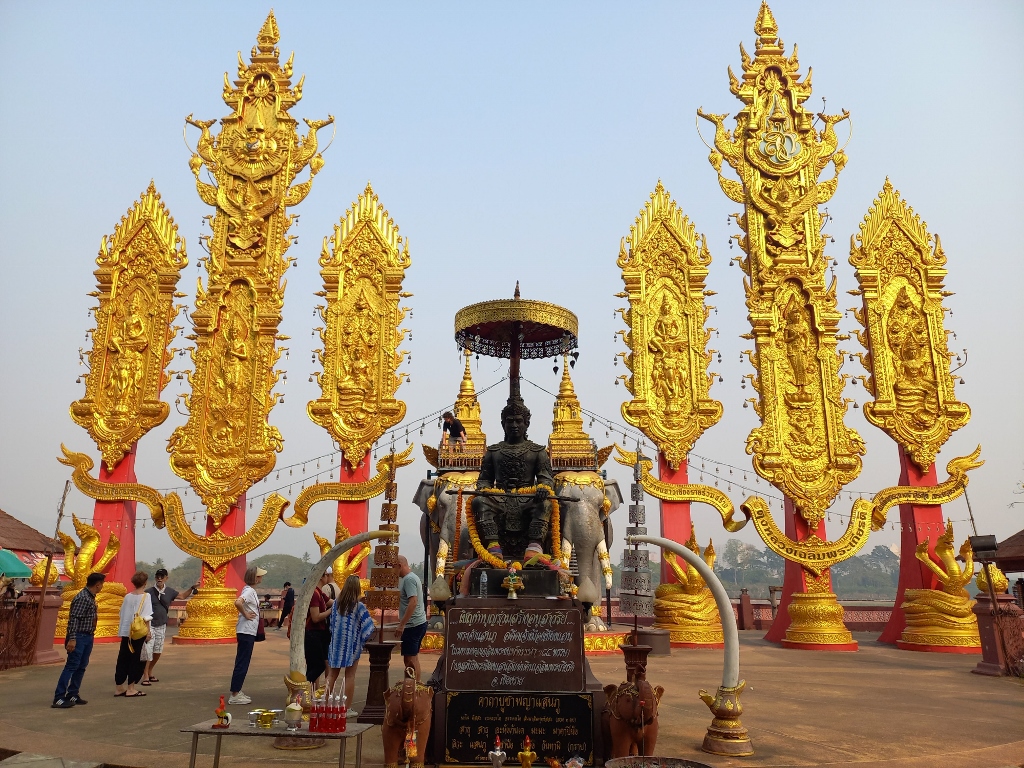 Promenade near the confluence of the Ruak and the Mekong, a detail
Promenade near the confluence of the Ruak and the Mekong, a detail
 Promenade near the confluence of the Ruak and the Mekong, a detail
Promenade near the confluence of the Ruak and the Mekong, a detail
There were, of course, numerous stalls offering a variety of goods, but that aspect wasn’t at all interesting for me. Besides coming here to see the confluence, the excursion also included a boat ride, so we went to the dock, joined other tourist groups and everyone was given a life jacket. In other words, everything was ready for the boat trip.
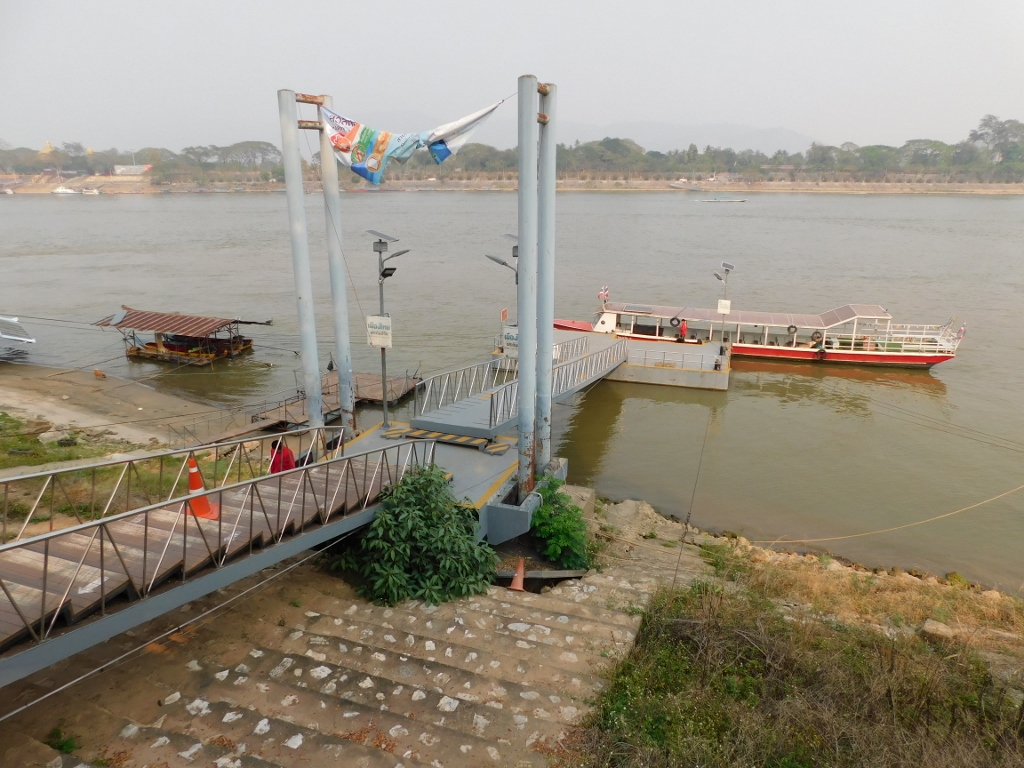 Pier for the boat excursion around the confluence of the Ruak and the Mekong
Pier for the boat excursion around the confluence of the Ruak and the Mekong
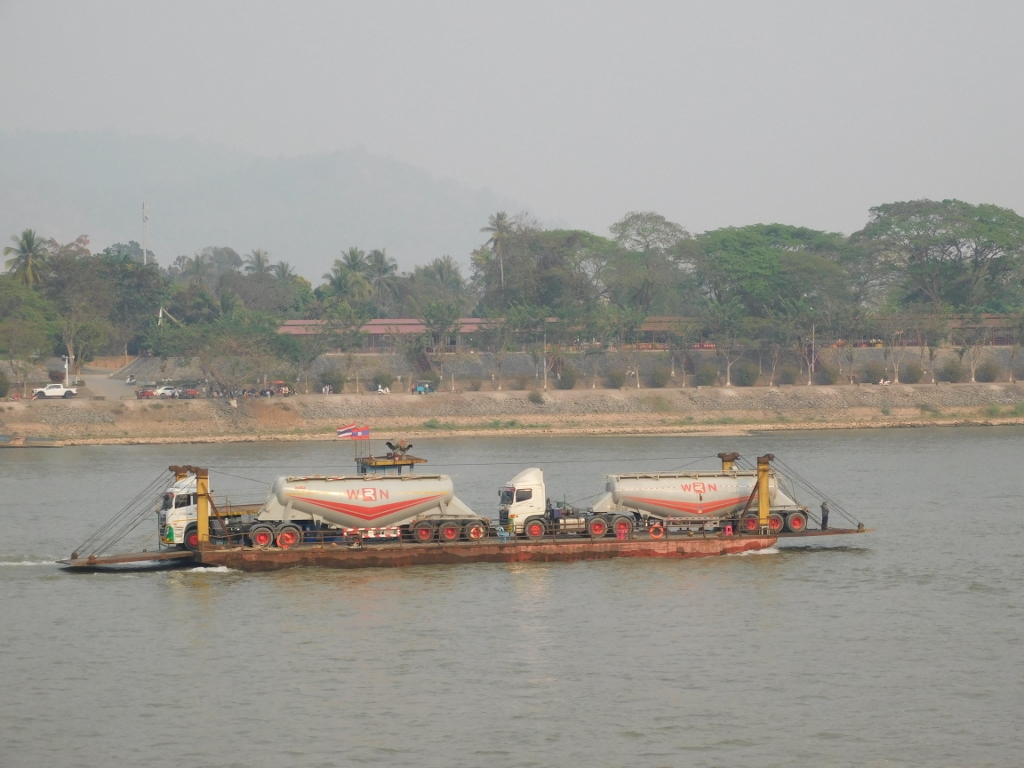 The Mekong River, a detail
The Mekong River, a detail
In reality, we were cruising on the Mekong the entire time, heading a bit north and then a bit south before returning to the dock we started from. However, we practically approached the shores of Laos and Myanmar. Although the scenes were undoubtedly interesting and I was extremely pleased with the diverse things I saw on this extraordinary day trip from Chiang Mai, the high humidity created that constant grey haze that coloured everything.
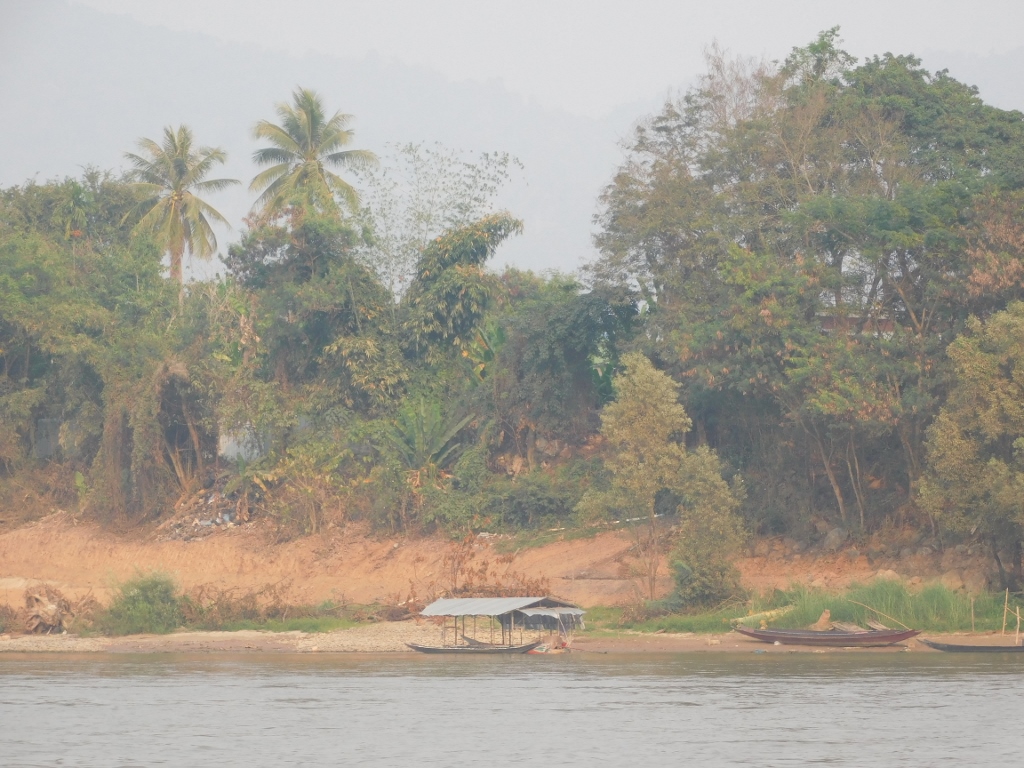 Boat ride along the Mekong River, a detail
Boat ride along the Mekong River, a detail
 Boat ride along the Mekong River, a detail
Boat ride along the Mekong River, a detail
 Boat ride along the Mekong River, a detail
Boat ride along the Mekong River, a detail
 Boat ride along the Mekong River, a detail
Boat ride along the Mekong River, a detail
To make the colours a bit livelier, the organisers of the trip offered us – Laotian beer! How could one pass up such a treat?
 Beer from Laos in the “international waters”
Beer from Laos in the “international waters”
 Beer from Laos in the “international waters”
Beer from Laos in the “international waters”
It seems that this beer did its job, because quite unusually, even after drinking it, I continued to take photos with the beer bottle as the main subject.
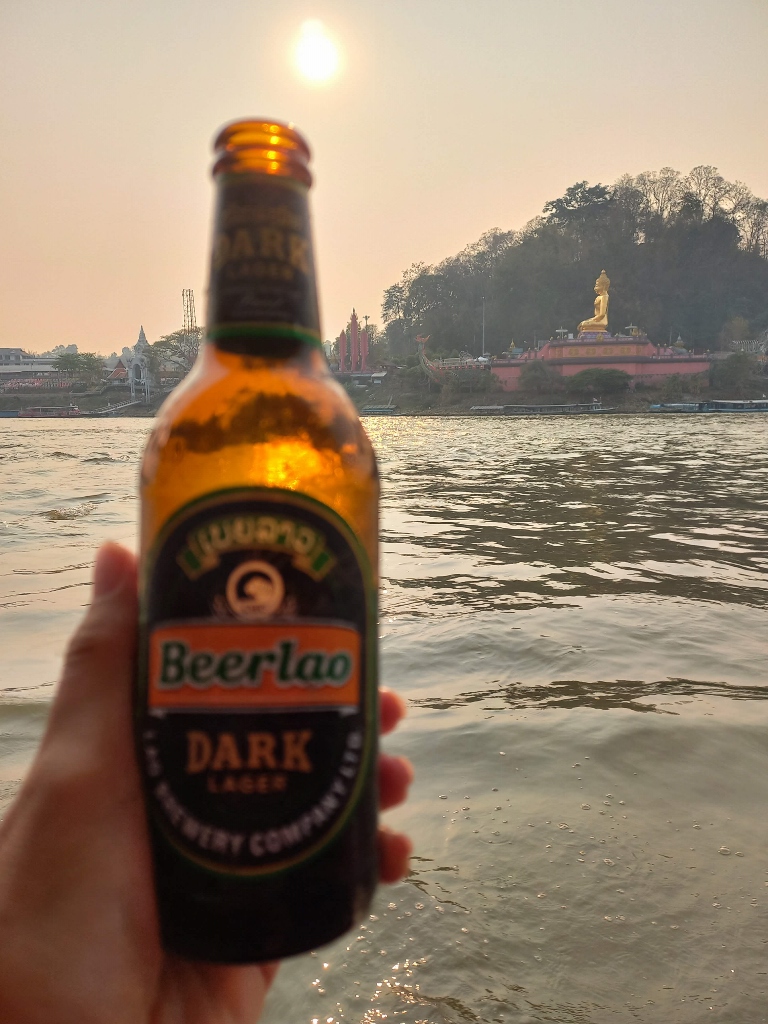 Beer from Laos in the “international waters”
Beer from Laos in the “international waters”
But, jokes aside, the beer wasn’t too strong or there wasn’t enough of it to leave a more lasting impression on me. So, I continued to observe the surroundings.
As the opium and heroin business declined, the resourceful residents of these areas realised that addiction is a profitable trait, especially for those who exploit it. That’s why large casinos and accompanying hotels started to pop up around here.
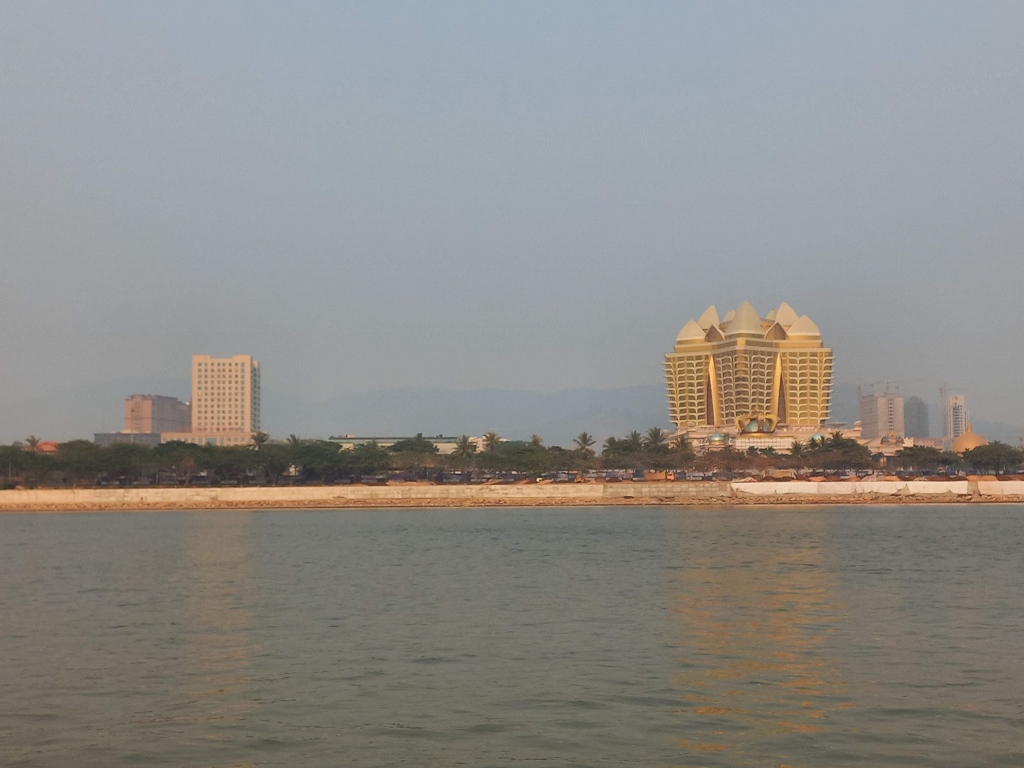 Boat ride along the Mekong River, a detail
Boat ride along the Mekong River, a detail
 Boat ride along the Mekong River, a detail
Boat ride along the Mekong River, a detail
I found it interesting to approach our boat captain who navigated the excursion boat, as if he were a truck driver.
 Boat ride along the Mekong River, a detail
Boat ride along the Mekong River, a detail
Here is a short video that shows what all of this looked like in motion.
After all of us from the excursion boat had returned the life vests, which fortunately we did not need, everyone went their separate ways with their respective groups. That included me. My group settled into the minibus and we headed back to Chiang Mai, which was approximately 255 km away from here.
It was a long drive of about 4 hours, but at the same time, it was a very satisfying day.
As we approached Chiang Mai, I found it interesting to observe some parts of the motorway that were impeccably marked with signage. This was particularly noticeable as it was already dark and everything was flashing like driving through a disco. There were very few cars and I wondered for whom they had made all of this, i.e., for whom they had invested so much.
I remained without an answer, but regardless, I arrived in Chiang Mai a bit earlier than expected and I even managed to capture one of the corner parts of the fortifications that surround the ancient centre of this city.
 Back in Chiang Mai
Back in Chiang Mai
That earlier return was especially welcome because the next morning, I had to get up very early and I wanted to send a few photos of the places I visited that day to my friends and family. Everyone was delighted.
In the meantime, I had to take care of the hygiene, as well. On this evening, a regular shower was not enough; my feet needed special attention and rubbing!
 Let’s clean the feet well
Let’s clean the feet well
And, most importantly, I also packed up and then went to bed. The next day, I was to move to the south, to the beach area.